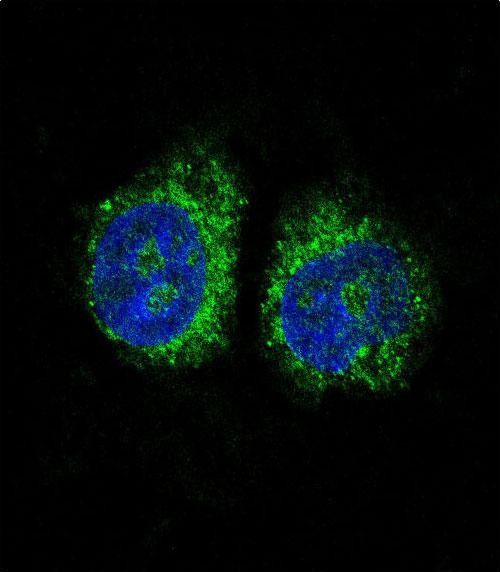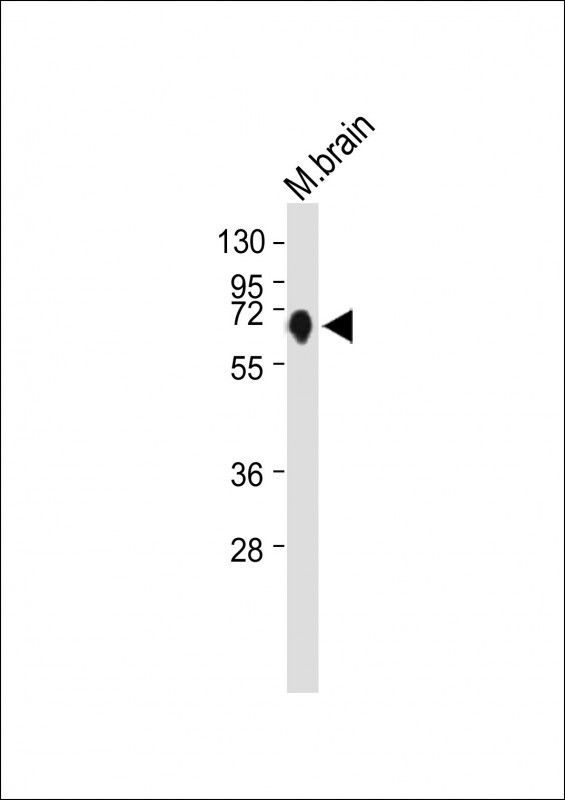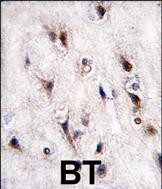NURR1 (NR4A2) Antibody (N-term)
Purified Rabbit Polyclonal Antibody (Pab)
- SPECIFICATION
- CITATIONS: 1
- PROTOCOLS
- BACKGROUND

Application
| WB, IF, IHC-P, E |
|---|---|
| Primary Accession | P43354 |
| Other Accession | Q07917, Q06219, Q08E53 |
| Reactivity | Mouse |
| Predicted | Bovine, Rat |
| Host | Rabbit |
| Clonality | Polyclonal |
| Isotype | Rabbit IgG |
| Calculated MW | 66591 Da |
| Antigen Region | 13-42 aa |
| Gene ID | 4929 |
|---|---|
| Other Names | Nuclear receptor subfamily 4 group A member 2, Immediate-early response protein NOT, Orphan nuclear receptor NURR1, Transcriptionally-inducible nuclear receptor, NR4A2, NOT, NURR1, TINUR |
| Target/Specificity | This NURR1 (NR4A2) antibody is generated from rabbits immunized with a KLH conjugated synthetic peptide between 13-42 amino acids from the N-terminal region of human NURR1 (NR4A2). |
| Dilution | WB~~1:1000 IF~~1:10~50 IHC-P~~1:50~100 E~~Use at an assay dependent concentration. |
| Format | Purified polyclonal antibody supplied in PBS with 0.09% (W/V) sodium azide. This antibody is prepared by Saturated Ammonium Sulfate (SAS) precipitation followed by dialysis against PBS. |
| Storage | Maintain refrigerated at 2-8°C for up to 2 weeks. For long term storage store at -20°C in small aliquots to prevent freeze-thaw cycles. |
| Precautions | NURR1 (NR4A2) Antibody (N-term) is for research use only and not for use in diagnostic or therapeutic procedures. |
| Name | NR4A2 |
|---|---|
| Synonyms | NOT, NURR1, TINUR |
| Function | Transcriptional regulator which is important for the differentiation and maintenance of meso-diencephalic dopaminergic (mdDA) neurons during development (PubMed:15716272, PubMed:17184956). It is crucial for expression of a set of genes such as SLC6A3, SLC18A2, TH and DRD2 which are essential for development of mdDA neurons (By similarity). |
| Cellular Location | Cytoplasm. Nucleus. Note=Mostly nuclear; oxidative stress promotes cytoplasmic localization |
| Tissue Location | Expressed in a number of cell lines of T-cell, B- cell and fibroblast origin. Strong expression in brain tissue |

Provided below are standard protocols that you may find useful for product applications.
Background
Parkinson's disease (PD) is a multifactorial disease that appears to arise from the effects of both genetic and environmental influences. The known genetic factors include multiple genes that have been identified in related parkinsonian syndromes, as well as alpha-synuclein. Genes associated with either PD or Parkinson-related disorders include parkin, DJ-1, ubiquitin C-terminal hydrolase isozyme L1 (UCH-L1), nuclear receptor-related factor 1 (NURR1), and alpha-synuclein. Nurr1 is a transcription factor that is expressed in the embryonic ventral midbrain and is critical for the development of dopamine (DA) neurons. It belongs to the conserved family of nuclear receptors but lacks an identified ligand and is therefore referred to as an orphan receptor. RXR ligands can promote the survival of DA neurons via a process that depends on Nurr1-RXR heterodimers. In developing DA cells, Nurr1 is required for the expression of several genes important for DA synthesis and function. Nurr1 is also important for the maintenance of adult DA neurons.
References
Perlmann T, et al. Cell Tissue Res. 318(1):45-52 (2004) Hsu HC,et al. Curr Drug Targets Inflamm Allergy. 3(4):413-23 (2004) Wallen-Mackenzie A, et al. Genes Dev. 17(24):3036-47 (2003) Ichinose,H., et al. Gene 230 (2), 233-239 (1999) Okabe,T., et al. J. Immunol. 154 (8), 3871-3879 (1995) Mages,H.W., et al. Mol. Endocrinol. 8 (11), 1583-1591 (1994)
If you have used an Abcepta product and would like to share how it has performed, please click on the "Submit Review" button and provide the requested information. Our staff will examine and post your review and contact you if needed.
If you have any additional inquiries please email technical services at tech@abcepta.com.














 Foundational characteristics of cancer include proliferation, angiogenesis, migration, evasion of apoptosis, and cellular immortality. Find key markers for these cellular processes and antibodies to detect them.
Foundational characteristics of cancer include proliferation, angiogenesis, migration, evasion of apoptosis, and cellular immortality. Find key markers for these cellular processes and antibodies to detect them. The SUMOplot™ Analysis Program predicts and scores sumoylation sites in your protein. SUMOylation is a post-translational modification involved in various cellular processes, such as nuclear-cytosolic transport, transcriptional regulation, apoptosis, protein stability, response to stress, and progression through the cell cycle.
The SUMOplot™ Analysis Program predicts and scores sumoylation sites in your protein. SUMOylation is a post-translational modification involved in various cellular processes, such as nuclear-cytosolic transport, transcriptional regulation, apoptosis, protein stability, response to stress, and progression through the cell cycle. The Autophagy Receptor Motif Plotter predicts and scores autophagy receptor binding sites in your protein. Identifying proteins connected to this pathway is critical to understanding the role of autophagy in physiological as well as pathological processes such as development, differentiation, neurodegenerative diseases, stress, infection, and cancer.
The Autophagy Receptor Motif Plotter predicts and scores autophagy receptor binding sites in your protein. Identifying proteins connected to this pathway is critical to understanding the role of autophagy in physiological as well as pathological processes such as development, differentiation, neurodegenerative diseases, stress, infection, and cancer.



